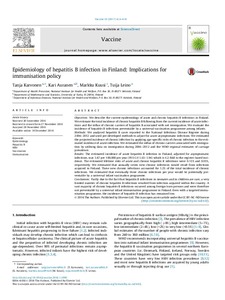Epidemiology of hepatitis B infection in Finland: Implications for immunisation policy
Tanja Karvonen; Kari Auranen; Markku Kuusi; Tuija Leino
Epidemiology of hepatitis B infection in Finland: Implications for immunisation policy
Tanja Karvonen
Kari Auranen
Markku Kuusi
Tuija Leino
ELSEVIER SCI LTD
Julkaisun pysyvä osoite on:
https://urn.fi/URN:NBN:fi-fe2021042716783
https://urn.fi/URN:NBN:fi-fe2021042716783
Tiivistelmä
Objectives: We describe the current epidemiology of acute and chronic hepatitis B infections in Finland. We estimate the total incidence of chronic hepatitis B following from the current incidence of acute infections and the influx of chronic carriers of hepatitis B associated with net immigration. We evaluate the incidence of hepatitis B infections preventable by a universal vaccination programme among infants.Methods: We analysed hepatitis B cases reported to the National Infectious Disease Register during 2004-2012 and used pre-developed methods to adjust for acute asymptomatic infections. We estimated the projected incidence of chronic infection by applying age-specific risks of chronic infection to the estimated incidence of acute infection. We estimated the influx of chronic carriers associated with immigration by utilising data on immigration during 2004-2012 and the WHO regional estimates of carriage prevalence.Results: The estimated incidence of acute hepatitis B infection in Finland, adjusted for asymptomatic infections, was 1.67 per 100,000 per year (95% Crl 1.43-1.94) which is 4.2-fold to the register-based incidence. The estimated lifetime risks of acute and chronic hepatitis B infections were 0.13% and 0.01%, respectively. We estimated that annually seven new chronic infections would result from infections acquired in Finland. These new chronic infections accounted for 1.2% of the total incidence of chronic infections. We estimated that eventually three chronic infections per year would be potentially preventable by a universal infant vaccination programme.Conclusions: Partly due to the fact that hepatitis B infections in neonates and in children are rare, a very limited number of chronic hepatitis B infections resulted from infection acquired within the country. A vast majority of chronic hepatitis B infections occurred among foreign-born persons and were therefore not preventable by a universal infant immunisation programme in Finland. Even with a targeted immunisation programme, the incidence of hepatitis B infection has remained low. (C) 2016 The Authors. Published by Elsevier Ltd. This is an open access article under the CC BY-NC-ND license.
Kokoelmat
- Rinnakkaistallenteet [27094]
